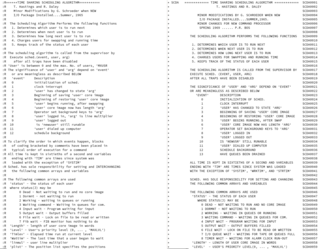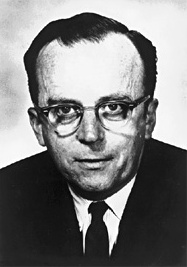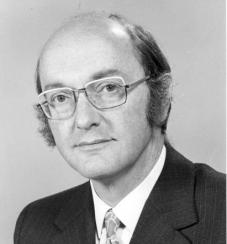Related Research Articles

In computing, multitasking is the concurrent execution of multiple tasks over a certain period of time. New tasks can interrupt already started ones before they finish, instead of waiting for them to end. As a result, a computer executes segments of multiple tasks in an interleaved manner, while the tasks share common processing resources such as central processing units (CPUs) and main memory. Multitasking automatically interrupts the running program, saving its state and loading the saved state of another program and transferring control to it. This "context switch" may be initiated at fixed time intervals, or the running program may be coded to signal to the supervisory software when it can be interrupted.
Internetworking is the practice of interconnecting multiple computer networks, such that any pair of hosts in the connected networks can exchange messages irrespective of their hardware-level networking technology. The resulting system of interconnected networks are called an internetwork, or simply an internet.

In computing, time-sharing is the sharing of a computing resource among many tasks or users. It enables multi-tasking by a single user or enables multiple user sessions.

In telecommunications, packet switching is a method of grouping data into packets that are transmitted over a digital network. Packets are made of a header and a payload. Data in the header is used by networking hardware to direct the packet to its destination, where the payload is extracted and used by an operating system, application software, or higher layer protocols. Packet switching is the primary basis for data communications in computer networks worldwide.

This article presents a detailed timeline of events in the history of computing from 1950 to 1979. For narratives explaining the overall developments, see the history of computing.

The Advanced Research Projects Agency Network (ARPANET) was the first wide-area packet-switched network with distributed control and one of the first computer networks to implement the TCP/IP protocol suite. Both technologies became the technical foundation of the Internet. The ARPANET was established by the Advanced Research Projects Agency (ARPA) of the United States Department of Defense.

The Compatible Time-Sharing System (CTSS) was the first general purpose time-sharing operating system. Compatible Time Sharing referred to time sharing which was compatible with batch processing; it could offer both time sharing and batch processing concurrently.

Joseph Carl Robnett Licklider, known simply as J. C. R. or "Lick", was an American psychologist and computer scientist who is considered to be among the most prominent figures in computer science development and general computing history.

Donald Watts Davies, was a Welsh computer scientist who was employed at the UK National Physical Laboratory (NPL).

Christopher S. Strachey was a British computer scientist. He was one of the founders of denotational semantics, and a pioneer in programming language design and computer time-sharing. He has also been credited as possibly being the first developer of a video game. He was a member of the Strachey family, prominent in government, arts, administration, and academia.
The CYCLADES computer network was a French research network created in the early 1970s. It was one of the pioneering networks experimenting with the concept of packet switching and, unlike the ARPANET, was explicitly designed to facilitate internetworking.

Louis Pouzin is a French computer scientist. He designed a pioneering packet communications network, CYCLADES that was the first to implement the end-to-end principle, which became fundamental to the design of the Internet.

Lawrence Gilman Roberts was an American engineer who received the Draper Prize in 2001 "for the development of the Internet", and the Principe de Asturias Award in 2002.

A computer network is a set of computers sharing resources located on or provided by network nodes. Computers use common communication protocols over digital interconnections to communicate with each other. These interconnections are made up of telecommunication network technologies based on physically wired, optical, and wireless radio-frequency methods that may be arranged in a variety of network topologies.

CP-40 was a research precursor to CP-67, which in turn was part of IBM's then-revolutionary CP[-67]/CMS – a virtual machine/virtual memory time-sharing operating system for the IBM System/360 Model 67, and the parent of IBM's VM family. CP-40 ran multiple instances of client operating systems – particularly CMS, the Cambridge Monitor System, built as part of the same effort. Like CP-67, CP-40 and the first version of CMS were developed by IBM's Cambridge Scientific Center (CSC) staff, working closely with MIT researchers at Project MAC and Lincoln Laboratory. CP-40/CMS production use began in January 1967. CP-40 ran on a unique, specially modified IBM System/360 Model 40.
This article covers the History of CP/CMS — the historical context in which the IBM time-sharing virtual machine operating system was built.

David Fielding Hartley FBCS is a computer scientist and Fellow of Clare College, Cambridge. He was Director of the University of Cambridge Computing Service from 1970–1994, Chief Executive of United Kingdom Joint Academic Network (JANET) 1994–1997, and Executive Director of Cambridge Crystallographic Data Centre (CCDC) 1997–2002. He is now much involved with the National Museum of Computing.

The NPL network, or NPL Data Communications Network, was a local area computer network operated by a team from the National Physical Laboratory in London that pioneered the concept of packet switching.
Security and Privacy in Computer Systems is a paper by Willis Ware that was first presented to the public at the 1967 Spring Joint Computer Conference.
References
- ↑ Lee, J.A.N.; Rosin, Robert F (1992). "Time-Sharing at MIT". IEEE Annals of the History of Computing. 14 (1): 16. doi:10.1109/85.145316. S2CID 30976386 . Retrieved October 3, 2022.
- ↑ Lee, J.A.N. (1992). "Claims to the Term "Time-Sharing"". IEEE Annals of the History of Computing. 14 (1): 17. doi:10.1109/85.145316. S2CID 30976386 . Retrieved October 3, 2022.
I did not envisage the sort of console system which is now so confusingly called time-sharing.
- ↑ Corbató, F. J.; Daggett, M. M.; Daley, R. C.; Creasy, R. J.; Hellwig, J. D.; Orenstein, R. H.; Korn, L. K. (1963). The Compatible Time-Sharing System A Programmer's Guide (PDF). MIT Press. ISBN 978-0-262-03008-3.
To establish the context of the present work, it is informative to trace the development of time-sharing at MIT. Shortly after the first paper on time-shared computers by C. Strachey at the June 1959 UNESCO Information Processing conference, H.M. Teager and J. McCarthy delivered an unpublished paper "Time-Shared Program Testing" at the August 1959 ACM Meeting.
- ↑ Roberts, Dr. Lawrence G. (November 1978). "The Evolution of Packet Switching". Archived from the original on March 24, 2016. Retrieved 5 September 2017.
Almost immediately after the 1965 meeting, Donald Davies conceived of the details of a store-and-forward packet switching system
- ↑ Roberts, Dr. Lawrence G. (May 1995). "The ARPANET & Computer Networks". Archived from the original on March 24, 2016. Retrieved 13 April 2016.
- ↑ Hartley, D. F. (1968), The Cambridge multiple-access system: user's reference manual, Cambridge: Cambridge Univ. Press, ISBN 978-0901224002
- ↑ Wilkes, M.; Needham, R. (1968), "The Design of Multiple-Access Computer Systems: Part 2" (PDF), The Computer Journal, 10 (4): 315–320, doi: 10.1093/comjnl/10.4.315
- ↑ Ritchie, Dennis M. (1977). The Unix Time-sharing System: A retrospective (PDF). Tenth Hawaii International Conference on the System Sciences.
a good case can be made that UNIX is in essence a modern implementation of MIT's CTSS system
- ↑ Seibel, Peter (2009). Coders at work : reflections on the craft of programming. New York: Apress. p. 463. ISBN 9781430219491.
The things that I [Ken Thompson] liked [about Multics] enough to actually take were the hierarchical file system and the shell
- ↑ McDonnell, Eugene. "The Socio-Technical Beginnings of APL" . Retrieved 18 January 2019.
- 1 2 "A partial history of CDC Operating Systems" (PDF). March 1976.
- ↑ Oral History of Martin A. Goetz, co-founder of Applied Data Research (ADR), interviewed by: Burt Grad and Luanne Johnson, December 10, 1985 at Princeton, New Jersey, Computer History Museum Reference No. X4579.2008 Archived 2012-03-24 at the Wayback Machine